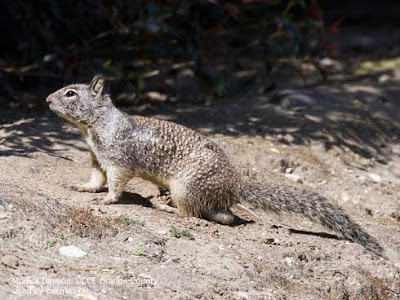
Sign up for free online workshop on rodent management

|
|
The California ground squirrel (
Otospermophilus beecheyi
)
can be a real nuisance for the home gardener.
(Photo by Monica Dimson, UCCE Orange County,
courtesy UC IPM) |
They’re clever, determined and usually hungry. That makes controlling rodents in our homes and gardens particularly difficult.
In a free online workshop, learn how to outsmart Norway rats, roof rats, mice, rabbits, voles and other common rodents – maybe even squirrels! Experts in integrated pest management will show you how.
Set for 1 p.m. Thursday, June 17, “IPM for Rodents” starts with identification and how to tell which critter is actually affecting your space. Then the workshop tackles how to dissuade rodents from eating your garden and invading your home.
The workshop is free, but advance registration is required at: https://ucanr.edu/sites/ucipm-community-webinars/.
Dr. Niamh Quinn, Human-Wildlife Interactions Advisor for Orange, Los Angeles, and San Diego counties, will present this workshop, designed for both urban and suburban dwellers.
Designed to be as wildlife friendly as possible, IPM methods control pests with mostly natural methods and strategies. This one-hour workshop is part of a new public series presented by the UC Statewide Integrated Pest Management Urban & Community Program.
Each month, IPM and other experts will share helpful pest management information for California residents, say the organizers. Since the workshops are online, they’re available throughout the state.
Topics also will include landscape pest management, household pests, understanding pesticides, management for weeds and invasive pests. Each webinar will be held at 1 p.m. on the third Thursday of the month.
Upcoming workshops: “Plant Diseases” (July 15), “Weed Identification” (Aug. 19) and “Identifying Insect Pests in the Home and Garden” (Sept. 16).
For more details and to register: https://ucanr.edu/sites/ucipm-community-webinars/ .
Comments
0 comments have been posted.Sacramento Digs Gardening to your inbox.
Food in My Back Yard Series
May 6: Maintain soil moisture with mulch for garden success
April 29: What's (already) wrong with my tomato plants?
April 22: Should you stock up on fertilizer? (Yes!)
April 15: Grow culinary herbs in containers
April 8: When to plant summer vegetables
April 1: Don't be fooled by these garden myths
March 25: Fertilizer tips: How to 'feed' your vegetables for healthy growth
March 18: Time to give vegetable seedlings some more space
March 11: Ways to win the fight against weeds
March 4: Potatoes from the garden
Feb. 25: Plant a fruit tree now -- for later
Feb. 18: How to squeeze more food into less space
Feb. 11: When to plant? Consider staggering your transplants
Feb. 4: Starting in seed starting
Sites We Like
Garden Checklist for week of May 4
Enjoy this spring weather – and get gardening!
* Plant, plant, plant! It’s prime planting season in the Sacramento area. Time to set out those tomato transplants along with peppers and eggplants. Pinch off any flowers on new transplants to make them concentrate on establishing roots instead of setting premature fruit.
* Direct-seed melons, cucumbers, summer squash, corn, radishes, pumpkins and annual herbs such as basil.
* Harvest cabbage, lettuce, peas and green onions.
* In the flower garden, direct-seed sunflowers, cosmos, salvia, zinnias, marigolds, celosia and asters. (You also can transplant seedlings for many of the same flowers.)
* Plant dahlia tubers. Other perennials to set out include verbena, coreopsis, coneflower and astilbe.
* Transplant petunias, marigolds and perennial flowers such as astilbe, columbine, coneflowers, coreopsis, dahlias, rudbeckia and verbena.
* Keep an eye out for slugs, snails, earwigs and aphids that want to dine on tender new growth.
* Feed summer bloomers with a balanced fertilizer.
* For continued bloom, cut off spent flowers on roses as well as other flowering plants.
* Add mulch to the garden to maintain moisture. Mulch also cuts down on weeds. But don’t let it mound around the stems or trunks of trees or shrubs. Leave about a 6-inch to 1-foot circle to avoid crown rot or other problems.